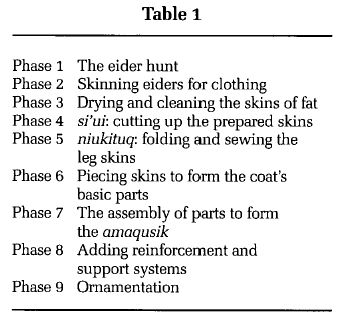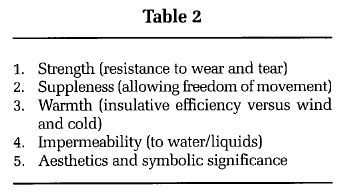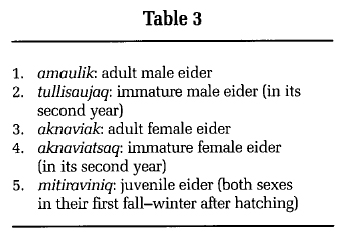Articles
Inuit Women's Knowledge of Bird Skins and its Application in Clothing Construction, Sanikiluaq, Nunavut
Abstract
This article is based upon a project carried out with the Qikirtamiut, Inuit of the Belcher Islands (Sanikiluaq, Nunavut), to reconstruct a woman's child-carrying coat (amaqusik) made from the skins of the Common Eider (Somateria mollissima). The Qikirtamiut, and in particular Qikirtamiut women, have developed an extensive corpus of knowledge about the skins of birds. This knowledge has its origins in their long history of use of bird skins for clothing. Their appraisal of the properties of these skins takes into account a variety of factors: species, age, sex, season of harvest, and condition. Qikirtamiut also differentiate between the properties of the feathered skin originating from different parts of the bird's body. These factors confer upon bird skins specific properties that influence in their turn their use in clothing construction. This analysis reveals not only the extensive knowledge that Qikirtamiut women have developed about bird skins, but also furthers our understanding of the contrasting qualities desired for different parts of a single garment, the eider skin coat.
Résumé
Cet article1 se fonde sur un projet mené avec les Qikirtamiut, Inuits des Iles Belcher (Sanikiluaq, Nunavut), qui a permis la reconstruction d'un amaqusik, manteau de femme avec une poche pour bébé, fait de peaux d'eiders à duvet (Somateria mollissima). Les Qikirtamiut, en particulier les femmes, ont développé un corpus de savoir très étendu sur les peaux d'oiseaux, dont l'origine est ancrée dans une longue tradition d'utilisation de ces peaux pour le vêtement. Les Qikirtamiut évaluent les propriétés des peaux en fonction de nombreux facteurs : espèce, âge, sexe, saison de la récolte, condition physique et différentes parties du corps de l'animal. Les propriétés de ces peaux déterminent leur usage. En plus de révéler l'étendue du savoir que les femmes qikirtamiut ont développé, cette analyse permet de mieux comprendre les différentes qualités recherchées pour chaque partie d'un vêtement, le manteau en peau d'eider.
1 Bird skin attire affords an exceptional opportunity for a subtle analysis of both Inuit knowledge and Inuit clothing. This same opportunity is not provided by the skins of caribou or reindeer (Rangifer tarrandus), even though this is the clothing material of choice for circumpolar peoples (for example, Hatt, 1969; Birket-Smith, 1929). Ironically, this is perhaps due to the fact that caribou skins are so well suited to the task. Harvested at the right time of year (early fall), they are warm and strong, while at the same time supple, light and not excessively bulky. They serve well for the construction of inner and outer coats for all family members, whether men or women, children, youth or adult. Furthermore, a caribou skin is of a suitably large size, and its surface of a fairly uniform quality. Accordingly, large coat parts, stretching from the hood to the coat tails, can be cut from a single caribou skin. In sum, the optimal and versatile nature of caribou skin facilitates its use for Arctic clothing, but restricts opportunities for a more subtle understanding of Inuit clothing requirements.
2 This is not the case for bird skins. Relative to caribou, they are warm, but considerably less resistant to wear and tear. The thick layer of plumage that provides insulation from cold also renders the skins bulky and inflexible. Furthermore, despite their small size, different parts of bird skins have very different characteristics, which must be taken into consideration in their use for clothing. Finally, as bird skins are small, many skins must be pieced together to construct a full coat.
3 These numerous "inconveniences" have encouraged Qikirtamiut women to refine their knowledge of eider skins, in order to make the most of this less than perfect clothing material. They distinguish between skins on the basis of age and sex, and also differentiate between the qualities of different skin parts. In this manner, they can select skins and skin parts offering characteristics best suited to the specific garment being made. This subtle differentiation goes so far as to identify specific skins for certain parts of garments, a process favoured by the need, at any rate, to piece together several skins in coat construction due to their small size. By observing the skin types chosen for specific parts of a garment, Qikirtamiut women also provide insights into the desired characteristics of certain elements of clothing (for example, strength for the garment shoulder; flexibility for a coat's hood).
4 This article is organized into two sections. The first considers the variety of skin types recognized by Qikirtamiut women and the qualities that they are attributed. The second observes in detail the choice of bird skins during the reconstruction of a specific garment, the woman's eider skin parka.
Methods
5 In the Belcher Islands, clothing made from the skins of eiders are called mitigaviniq or mitijak. Since 1914, when Flaherty "rediscovered" these islands in southeastern Hudson Bay, several bird skin parkas have made their way into museum collections in Quebec City, Ottawa, Toronto and Winnipeg. Apart from their presence in these collections and the occasional comment by explorers (Flaherty, 1918; Renouf, 1921) and anthropologists (Desgoffe, 1955; Guemple, 1966, 1967; Freeman, 1967), we know little about this unusual clothing adaptation of the Qikirtamiut.
6 Clothing research by Sylvie Pharand (n.d.) carried out in the early 1970s represents a first attempt to probe the many unknowns. Her descriptions of several eider skin parkas made in the Belchers and presently held at the Musée de la civilisation in Québec (Québec) provide a first perceptive analysis of the patterns of the coats, the skin types employed and the lexicon of specialized terms. Additional information is available from Oakes (1992), who has attempted a more complete account of eider skin garment construction. The restricted period of her field work (two weeks), however, limits the scope and accuracy of her observations.
7 The present data were collected as part of a project to reconstruct an eider skin coat supported by the Musée de la civilisation.2 Three field sessions were conducted in Sanikiluaq: background research in July-August 1988; observation of the hunt, skinning and cleaning process in November-December 1988 (Table 1, phases 1 to 3); and documentation of skin preparation and coat assembly in March-April 1989 (Table 1, phases 4 to 9).
8 The artifact chosen for reconstruction was an eider skin amaqusik, the woman's coat with a back pouch to carry a child. The amaqusik is a particularly challenging article of clothing to produce. In addition to fulfilling the standard requirements of warmth, ventilation, suppleness and durability, the amaqusik must be designed to accommodate the diverse interactions between mother and child.
9 Qikirtamiut eider skin coat construction was analysed as a sequence of technical operations, "une chaîne opératoire," a method for the study of the technological process developed by André Leroi-Gourhan (1965). The chaîne opératoire observed for the project can be divided into nine phases (Table 1).
10 In this article, we focus on the use of different eider skin types in relation to the pattern of the woman's coat, as well as their placement relative to the human body (phases 6 and 7).
Bird Skin Qualities and Clothing Requirements
11 The Qikirtamiut, and in particular Qikirtamiut women, have developed an extensive corpus of knowledge about the skins of birds. This knowledge finds its origins in their long history of bird skin use for clothing. Their appraisal of the properties of these skins takes into account a variety of factors: species, age, sex, season of harvest, and condition. Qikirtamiut also differentiate between the properties of the feathered skin originating from different parts of the bird's body. These factors, combined in a variety of ways, confer upon a bird skin specific properties.
12 When discussing bird skins as raw material for clothing, Qikirtamiut women drew attention to several requirements (Table 2).
13 The relative importance of these requirements varies with each garment type, as well as between different parts of the same garment. Bird skins vary in their abilities to fulfil these contrasting requirements. Skins that are strong and warm tend to be stiffer and bulky. They offer durability, but only at the expense of flexibility. Qikirtamiut women use their extensive knowledge of the properties of specific skins to seek their optimal disposition among the garments they are fabricating.
Bird Skin Qualities Relating to Age and Sex
14 In the Belcher Islands, as in adjacent Arctic Quebec, the Inuit refer to the Common Eider as mitiq. Beginning with the newly hatched duckling and terminating with the adult male and female, the author (Nakashima, 1991) recorded fourteen distinct terms from Qikirtamiut hunters, each referring to a different age-sex category of the Common Eider. Of these terms, five were utilized by the women when discussing coat construction (Table 3).
15 The skin of the adult male eider is easily distinguishable from others due to its striking jet-black belly that contrasts sharply with a snow-white breast, neck and mantle. To the uninitiated, however, the four remaining age-sex categories are more difficult to differentiate due to their more subtle differences in colouration and patterning. It is understandable therefore that other observers of Qikirtamiut coat construction have failed to distinguish correctly between these eider skins. For the five eider coats collected in the Belcher Islands in 1971, Pharand (n.d.) and Saladin d'Anglure (n.d.) differentiate between only three eider skin types as follows: "amaulik — male eider," "arnaluk — female eider," and "mitigait — eider duck." In her observations of the construction of two coats (for a man and a woman), Jill Oakes (1992: 4) also recognizes only three eider skin types: "male, female and immature male eiders."
16 This failure to recognize the full range of eider skin categories that are salient to Qikirtamiut women introduces certain ambiguities in their analyses and inevitably misrepresents and underestimates the subtlety of Qikirtamiut knowledge. It is likely that the category of "female eider," as designated by Pharand and Saladin d'Anglure, in actual fact includes not only adult and immature females, but also juveniles of both sexes, and perhaps even immature males. Similarly, Oakes' category of "female" probably includes both adult and immature females, as well as juvenile eiders of both sexes.
17 While fretting over such fine distinctions between eider age-sex categories may seem finicky and largely irrelevant to the outsider, this is hardly the case for the Qikirtamiut. When it comes to dividing up the catch from an eider hunt, hunters pay careful attention not only to the number of birds each family receives, but also to the even distribution of juveniles, immatures, sub-adults and adults of both males and females. In similar fashion, Qikirtamiut women sort eider skins available for coat construction according to each eider's age and sex, so as to plan for their optimal deployment among the clothing articles being constructed.
18 What then are the qualities of the skins coming from these five eider age-sex categories? Perhaps the easiest answer is to first describe those skins situated at opposite ends of a spectrum — the skins of adult eider males at one extreme, and juveniles at the other.
19 Among the five eider types listed above, the skin of the amaulik, the adult male, is recognized to be the thickest and the toughest. For this reason, its use is reserved first and foremost for the coats of active hunters. Hunters require clothing that resists tearing and bursting when subject to the strenuous and brusque movements required by the hunt. While praised for their strength and durability, amaulik skins suffer from the fault of being bulky and stiff, due to the thick mass of feathers that constitutes their plumage.
20 The skins of juvenile eiders, or mitiraviniq, contrast in a number of ways with those of adult males. Mitiraviniq are eider fledglings of both sexes that were just hatched the previous summer. The literal meaning of the term is "those that previously were ducklings" or mitiraq. Juvenile skins are supple and fragile. For this reason they are the material of choice for the coats of children. Qikirtamiut women specified that it was important that a child's coat be supple so as not to hamper their movements and be uncomfortable.
21 Juvenile skins are recognized as having another quality in addition to suppleness. Their plumage is less bulky than that of adult birds, the feathers lying flat, closer to the skin surface. This absence of bulk is the main explanation for the use of juvenile skins along the leading edge of men's hoods. Typically a single skin is used for this purpose. It is sliced longitudinally, along the ventral midline, and the halves are positioned on each side of the hood such that the cut edge forms the hood's leading edge. For this particular part of the parka, juvenile eider skins are considered to be the material of choice.
22 Between the extremes of the adult male eider skin — strong but bulky and stiff, and the juvenile skin — supple and sleek but fragile, are arranged the skins of the other eider categories whose strength and suppleness are intermediate in quality. One Qikirtamiut woman ordered skin types according to their strength and resistance to tearing. She stated a preference first and foremost for the skins of the amaulik, the adult male eider, the most durable of eider skins. Lacking this skin type, she then selected tullisaujaq, the immature male eider. If these were in their turn not available, she would then utilize the skins of aknaviak, the adult female eider. If all of these other skins were in short supply she would, as a last resort, use the skins of the aknaviatsaq or immature female eider, which are the least strong of these skin types.
23 It might seem odd to consider qualities of eider skins for winter coat construction and to discuss relative durability, suppleness, plumage bulk, but not relative warmth. When we asked Qikirtamiut about this, they explained that all eider skins are equally warm, so long as they are not torn or punctured. These comments provide an immediate explanation for their preoccupation with the strength and durability of eider skins.
24 Physical properties, however, are not the only consideration. The adult male eider is considered to be wily and difficult to kill. Adult male skins thus serve as a symbol of a man's status, and the man who wears coats made entirely of amaulik skins marks himself as a capable hunter. For this reason, amaulik skins were first reserved for the hunter's outer coat. The outer coat, drawn over an inner coat also made of eider skins, is worn feathered surface outward. When a hunter is on the land in winter, it is the feathered surface of the outer parka that is visible to those around him. An outer parka whose body and sleeves are entirely composed of the distinctive black ventral plumage of the adult male eider thus serves as unmistakable testimony of the man's prowess as a hunter.
25 As the skins of adult male eiders combined physical strength and symbolic importance, they were highly prized and jealously guarded. As one woman qualified while expounding upon the Inuit virtue of sharing:
26 To collect enough adult male eider skins for an entire outer coat (about seventeen skins for the coat's body and sleeves) is not always a simple task, however, and the hunter at times has to be satisfied with a coat of mixed skin types.
Skin Properties Specific to Body Part
27 Inuit not only distinguish between the skins of various eider types, but also discriminate between the parts of the same eider skin, each part having its own particular name and use. The five major named parts relate to the manner in which the skin is cut up for use in clothing production: (1) the qungiak (neck, upper chest and upper back); (2) the timik (breast and belly); (3) the qulusuk (back); (4) the upatik or nuluk (area surrounding the eider's tail — rump and hind belly); and (5) the downy sallik (wing pockets), which are situated on each side of the body between the belly and the back.
28 Through a clever sequence of cuts, the cased eider skin is transformed from a three-dimensional pouch into a more or less flat skin (Fig. 1). After this operation, the large sheet of skin referred to as the timik includes not only the breast and belly, but also most of the upatik, including not only the ventral hind belly, but also the dorsal rump. The timik is the warmest part, undoubtedly due to the fact that the eider spends the greater part of its existence afloat in frigid seas, relying largely upon this ventral cushion of feather and down to remain warm, dry and buoyant. The large timik portion of the eider skin is the principle material for the coat.
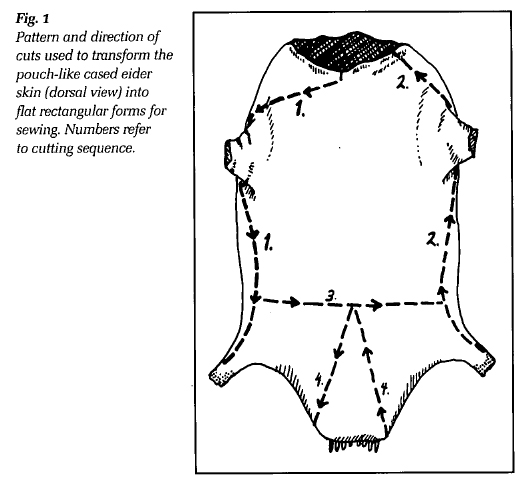 Display large image of Figure 1
Display large image of Figure 129 In contrast, the qulusuk or back skin is much more sparsely feathered and small. It is also thin and fragile as any taxidermist who has ruined a mount by tearing the back skin is apt to know. For these reasons these small portions of skin, trimmed into square or rectangular forms, are reserved for two uses, the sides and back of the hunter's hood and on occasion, the apron and tail of the woman's coat (Nakashima, 1989).
30 The qulusuk offers the advantage of being extremely supple, facilitating, in the case of the hunter's hood, the movement of the head when hooded, as well as the dropping back of the hood onto the shoulders. In the case of the tails of the woman's coat, its flexibility allows free movement of the legs. But this practical consideration may not be the only one, nor the most important. The adult male's qulusuk skins bear the striking pattern of a deep black triangle on a background of white feathers. To form the sides and back of the man's hood, these back skins are sewn one above the other into three vertical strips which are then attached side by side. As the qulusuk skins are all oriented with feathers pointing downwards, the finished product has the pleasing appearance of three ascending rows of deep black triangles against a background of pure white.
31 We turn now to the sallik, the wing pockets located on the bird's sides. The sallik skin bears no quilled contour feathers but only soft down. For this reason, it is reserved for a special task, the patching of holes or tears in eider skins. A hole is patched by sewing a small square of eider skin over the opening. The patch is oriented such that its own downy surface is applied to the unfeathered side of the skin being repaired. The sallik skin is perfect for this task because its feathered surface is free of contour feathers whose stiff vanes prevent a tight, wind-proof seal. Its soft downy feathers, on the other hand, do not interfere with the stitch and prevent the patched area from becoming a cold spot on the coat's surface.
32 The lack of contour feathers makes the sallik skin excellent for patching but less useful for warmth. For this reason these lateral areas of downy skin are trimmed from the sides of the thick and warm breast and belly skin (timik). When skins are plentiful, only a very narrow band of sallik skin is left along each side of the belly skin. This strip of downy sallik skin, free from contour feathers, facilitates the sewing of one skin to its neighbour. Such coats with the sallik skin essentially removed are particularly warm and bear a special name, sallikituq, which translates literally as "it is without sallik." But when eider skins are scarce, the extra breadth provided by the wing pocket areas mean that a coat can be made from fewer skins. To economize, most of the sallik skin area is left on the sides of each breast-belly skin, resulting in cold spots and a coat that is not as warm.
33 Finally, even the tiny and finely-feathered skins of the eider's head and neck have a use suited to their small size and frailty. Qikirtamiut sew them together with fine stitches to form warm and exceptionally delicate bonnets for newborn babies. Several Qikirtamiut women spoke with great admiration of a woman, the mother of a present-day community elder, who made a woman's parka entirely from the head and neck skins of eiders. This feat won her considerable renown as an exceptional seamstress. The head and neck skins of the eider are remarkably soft and velvety and as no Belcher Island coats of such unusual and meticulous design have been preserved, we can only imagine how exquisite a work of art it must have been. Hatt (1969), citing Khvostov and Davydov (1810), mentions a large Kodiak Island (Alaska) coat made exclusively of "the extremely beautiful, velvety neck portion" of the Pelecanus urile. For this masterpiece, 140 neck skins were required.
Disposition of Bird Skin Types and Construction of a Woman's Eider Skin Coat
34 The fabrication of a coat from the much larger skins of caribou can be described as a two-stage process. First, elements that conform in shape and size to the coat pattern are cut from prepared hides. Second, these elements are assembled together to form the coat. Bird skin parka fabrication differs from this process in one aspect. As bird skins are considerably smaller, several skins must be pieced together into larger composite forms. Thus, bird skin coat construction is a three stage process involving first the piecing together of bird skins, second, the shaping of these composite elements as required by the pattern, and third, the assembly of these elements to form the coat.
35 This technical solution to the problem of making clothing from the skins of small animals is shared with the Inuit of Greenland (Hatt, 1969; Holtved, 1967) and southwest Alaska (Hatt, 1969). In these regions, due to the particularly small size of the birds and mammals used (for example, the Dovekie, Plautus allé, in Greenland and the Arctic ground squirrel, Spermophilus parryh, in southwest Alaska), the skins are first joined side by side into horizontal belts, which are then vertically juxtaposed and sewn together to form a many-tiered piece (Hatt, 1969; Holtved, 1967). When piecing together the somewhat larger Common Eider skins, Qikirtamiut adhere to a more complex formula that does not generally entail the sewing of skins into belts.
36 In stage one of the Qikirtamiut process, eider skins are pieced together to form the eight major components which, when assembled, will form the coat. These parts are the (1) saa or chest panel; (2) tunuk or back panel; (3) allinik, the sides and back of the hood; (4) qallinik, the top of the hood; (5) and (6) aiq, the sleeves (right and left); (7) kinjq, the front apron; and (8) akuq, the tail flap. Each of these parts is a flat, two-dimensional composite of several skins. In stage two they are shaped by cutting away superfluous skin with the ulu. By joining these parts together in stage three, the woman's coat, amaqusik, is given its definitive three-dimensional form.
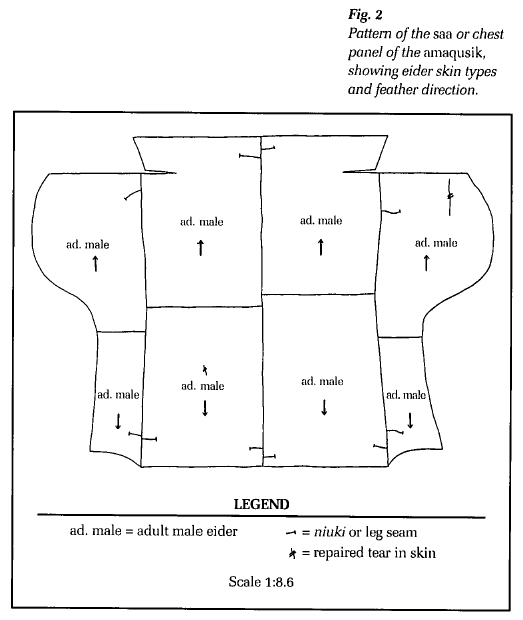 Display large image of Figure 2
Display large image of Figure 2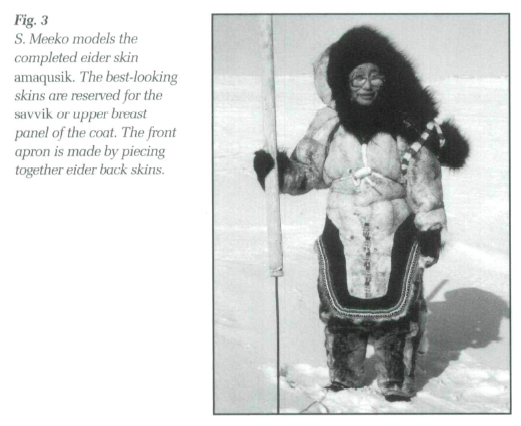 Display large image of Figure 3
Display large image of Figure 3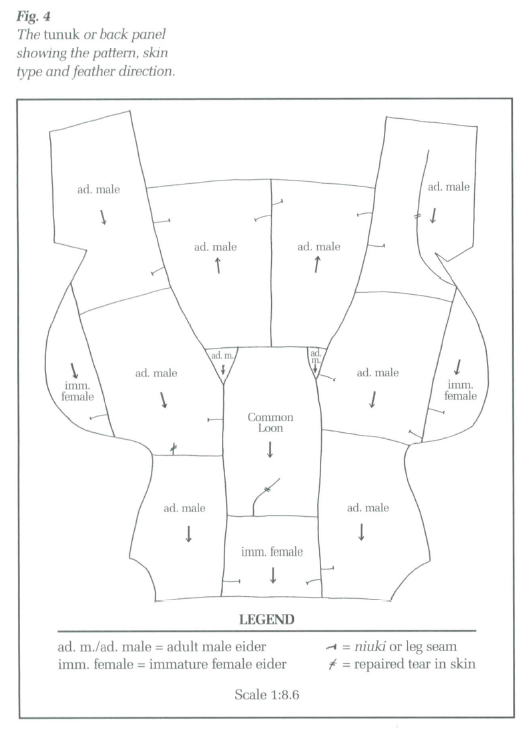 Display large image of Figure 4
Display large image of Figure 4Skin Choice for the saa (Chest Panel) — Strength and Appearance
37 While Qikirtamiut women agreed that the woman's coat was generally made from adult female eider skins, in the reconstruction project adult male skins were preferred on several occasions. The chest panel of the amaqusik, for example, was made from seven adult male eider skins (Fig. 2). These are reputed to be the toughest of eider skins, the least likely to burst or tear under stress. Selection of durable skins for the upper breast or savvik (the two central skins of the upper tier) is of particular importance. This area of the front panel helps support the weight of the child in the pouch and is subject to the stress imposed by the movement of the mother's arms and actions such as the shifting of the child to the front of the coat for breast-feeding.
38 The woman sewers were also concerned about the appearance of the saa and in particular of the savvik. The four "best-looking" skins were selected for the central panel and the best two of these became the savvik, the upper tier (Fig. 3). As the amaqusik is an inner coat, worn skin surface outward, the primary consideration was not the appearance of the plumage, but rather the appearance of the inner skin surface. A skin surface that is very white and unblemished is considered most desirable. Exceptionally white skins are said to come from very fat eiders whose skins were cleaned of fat soon after being killed. These skins are further bleached by an extended period of frost-drying (Speck, 1937, 348). The longer they are exposed to sub-zero temperatures, the whiter they are reported to become. Thus the selection of the whitest skins for the most visible part of the coat, the savvik or breast panel, bears witness to the hunter's prowess (having captured fat eiders) and the meticulous preparation by the woman.
Skin Strength and Impermeability for the tunuk or Back Panel
39 Piecing together the tunuk is complicated by the presence of the shoulder panels and the back pouch for carrying the child. Here again, durable skins were particularly sought after for the shoulders, pouch and upper back. For this reason, the skins of adult male eiders figure prominently among the ten Common Eider skins used for the back panel (Fig. 4).
40 Of particular interest, however, is the presence of the skin of another bird species, the only non-eider skin used in the entire coat. This skin is that of a Common Loon (Gavia immer). It is strategically positioned so as to line the bottom of the child-carrying pouch (Fig. 5). If the child should urinate in the pouch, the loon's highly water-repellent plumage allows the mother to easily tip the urine out onto the ground behind her by pulling the back of the coat away from her body and leaning forward. As the plumage of other bird skins is not as waterproof, their feathers allow the urine to penetrate down to the skin, causing rotting and loss of feathers. As a result, the child-carrying pouch becomes cold. When a loon skin is not available for this usage, an adult male eider skin is the next best choice.
Great Suppleness for the nasaq or Hood
41 The hood or nasaq is composed of two parts: the allinik (lower) and the qallinik (upper). The hood shelters the head but is not subject to stress and strain as it does not carry any weight. Instead, suppleness is of vital importance, as the hood must drape over the woman and child's heads, and lie close in order to retain warmth and exclude gusts of wind (Fig. 6). To fulfill this requirement, the women chose for the allinik the skins of six immature males, one immature female, and one adult female. Of the five skins required for the qallinik, which is the top of the hood and therefore particularly in need of being supple, all are immature female eiders, the most fragile and flexible of eider skins (Fig. 7).
Both Strength and Flexibility for the aiq or Sleeves
42 Each aiq or sleeve is made from the equivalent of two and one-half eider skins. The woman who made the sleeves for the present coat opted for durability and used two adult male eider skins for the upper part of the sleeve. She explained that the sleeve had to be strong where it joined the shoulder and was subject to much movement. At the cuff, however, a half skin from an immature female was added (Fig. 8). Here the requirement is great flexibility to allow the lower sleeve to be rolled up when the woman is working so as to avoid soiling with grease or blood. Unlike for western clothing, when the lower sleeve is rolled up, it is turned inwards.
43 The fragile but supple skins of the immature female eider are used in another strategic location. When the sleeves are attached, a strip of immature female eider skin called the uniq serves to join the lower edge of the sleeve to the body of the coat (Fig. 9). This makes for a very flexible junction between sleeve and torso, almost like a hinge, that lies beneath the armpit. Here it is not subject to the same stress as the skin above the shoulder (made of adult male skins), but must be very supple. Thus the choice of immature female skin.
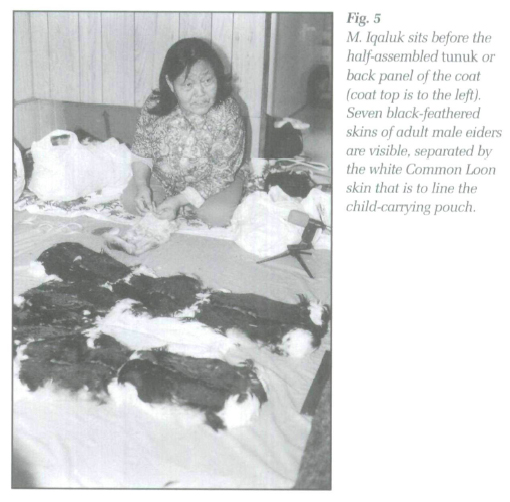 Display large image of Figure 5
Display large image of Figure 5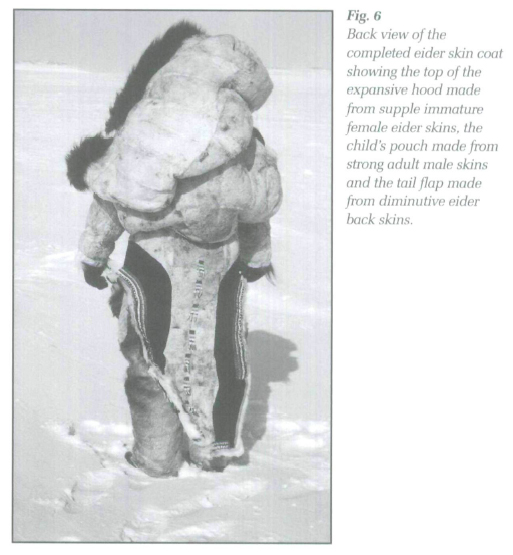 Display large image of Figure 6
Display large image of Figure 6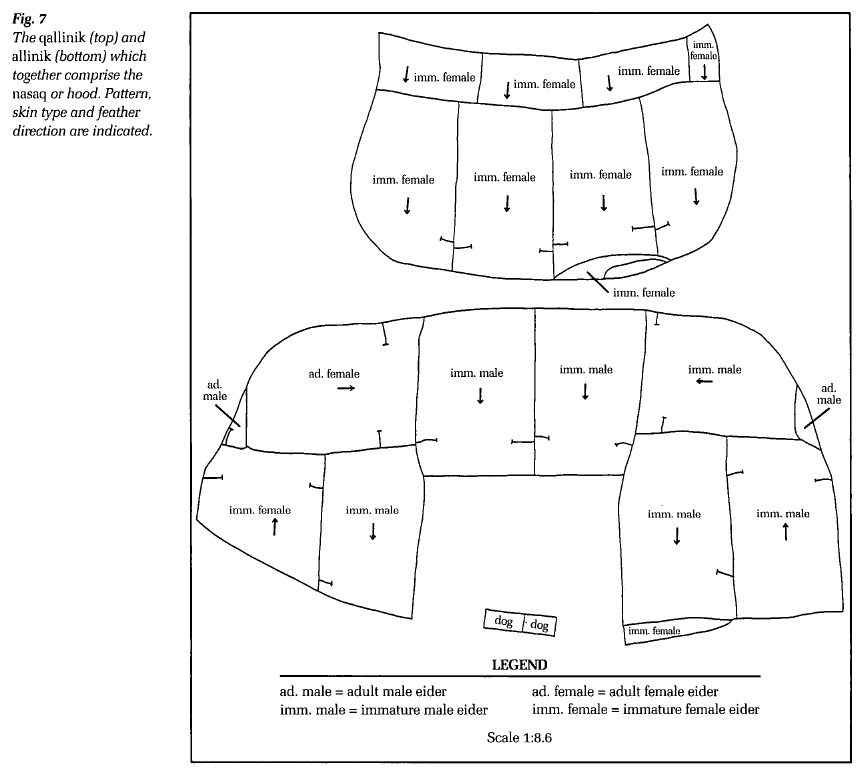 Display large image of Figure 7
Display large image of Figure 7Beauty for the kiniq or Apron, and akuq or Tail Flap
44 The apron and tail flap of the amaqusik are subject to wear and tear. Whenever possible they were made of dog skin, a tough and durable material. If dog skin was not available, however, bird skins were used in its place. Bird skin flaps were not made from the same part of the skin as the rest of the coat. Rather than the large and thickly feathered breast skins, the small squares cut from the eider's back were employed.
45 All the women's bird skin coats in museum collections known to the author possess flaps made from dog skin. For this reason, it was decided to make the front apron and tail flaps of this coat from eider back skins, the qulusuk, in order to observe and record the techniques involved.
46 A series of eider back skins are attached top to bottom to form narrow, vertical strips. For the shorter front apron, a total of fourteen back skins are utilized. The longer but narrower tail flap is composed of a total of twenty-three back skins. Feather orientation of all skins is from top to bottom. The back skins of all types of eiders may be used for the apron and tail flap. However, when adult male back skins are used, as for this reconstructed coat, the end product is strikingly decorative with rows of stark black triangles set against a background of fine white feathers.
Conclusion
47 When asked about the preferred choice of eider skins for coat construction, Qikirtamiut invariably indicated that men's coats were to be made from the skins of the adult male eider (amaulik), women's coats from the skins of the adult female eider (aknaviak), and the coats of children from immature female eiders (akanaviatsaq) or fledglings (mithaviniq).4 This symmetry whereby the skins of eiders of a particular age and sex are destined to make coats for humans of the "equivalent" age and sex underlines a fundamental element in indigenous worldview: the unity of human and animal experience.
48 As we have seen with the reconstruction of the woman's eider skin coat, however, norms and practice do not always correspond. As one woman explained:
49 All tallied at the end of the project, the woman's coat was indeed not made only from adult female eiders. In fact, four different eider skin types were used, as well as one skin of a completely different bird species (Common Loon). For each skin type an explanation was provided as to why it was the best choice for that specific part of the garment.
50 While adult male eider skins were reserved first and foremost for the men's coats, if surplus skins of this type were available, then they were used where strength is required. As we have seen with the reconstruction of the woman's coat, adult male eider skins were used: over fire shoulders, across the upper chest and back, to form the baby-carrying pouch, and for the upper sleeves. Immature female eider skins, on the other hand, were preferred where great suppleness was required: the hood, and especially its top, the cuff on the sleeves, and the underarm joint between sleeve and coat body. Finally, where impermeability was at a premium, such as to line the bottom of the child-carrying pouch, the Common Loon skin was preferred due to its highly waterproof plumage.
51 This examination of eider skin clothing highlights not only the extensive knowledge that Qikirtamiut women have developed about bird skins. It also provides further insights into the nature of Inuit clothing and the particular qualities sought for specific parts of the woman's bird skin dress.
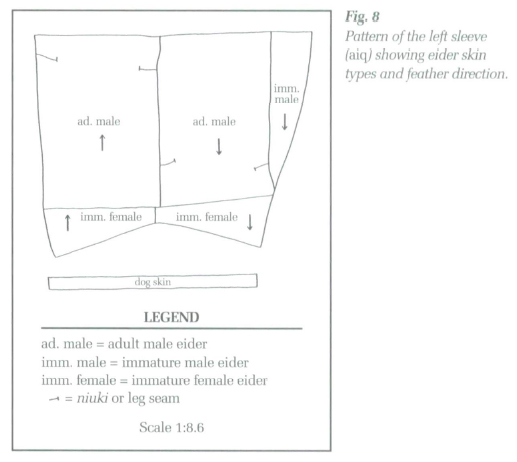 Display large image of Figure 8
Display large image of Figure 8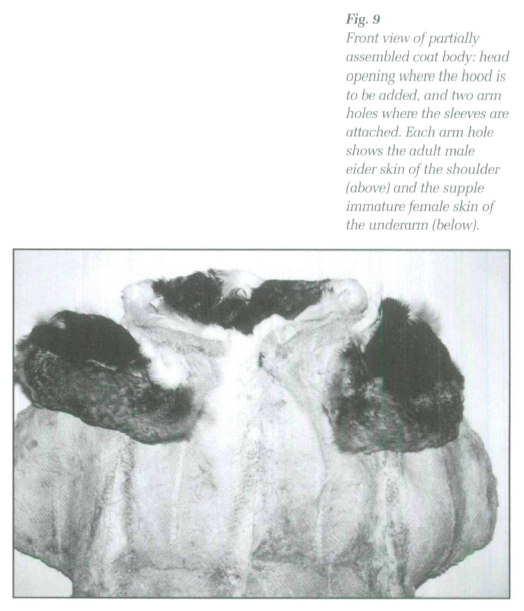 Display large image of Figure 9
Display large image of Figure 9Editor's note: the Inuktitut language uses various orthographies. For this article, terminology has been verified for the author by local (Sanikiluaq) interpreters.
